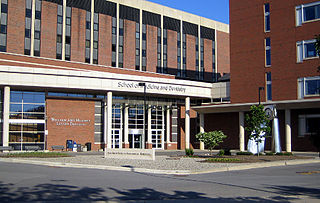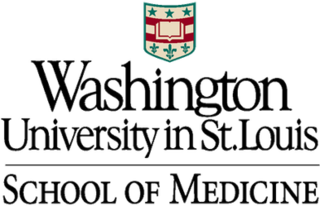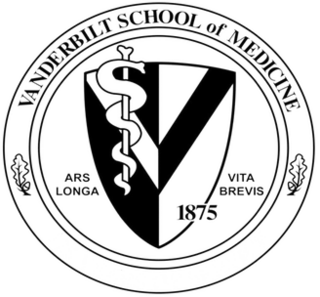
The University of California, San Francisco (UCSF) is a public land-grant research university in San Francisco, California. It is part of the University of California system and is dedicated entirely to health science and life science. It conducts research and teaching in medical and biological sciences.
The Stanford University School of Medicine is the medical school of Stanford University and is located in Stanford, California, United States. It traces its roots to the Medical Department of the University of the Pacific, founded in San Francisco in 1858. This medical institution, then called Cooper Medical College, was acquired by Stanford in 1908. The medical school moved to the Stanford campus near Palo Alto, California, in 1959.

Stanford University Medical Center is a medical complex which includes Stanford Health Care and Stanford Children's Health. It is consistently ranked as one of the best hospitals in the United States and serves as a teaching hospital for the Stanford University School of Medicine. In 2022–23, it was ranked by the US News as the 3rd-best hospital in California and 10th-best in the country.
The University of Texas Southwestern Medical Center is a public academic health science center in Dallas, Texas. With approximately 23,000 employees, more than 3,000 full-time faculty, and nearly 4 million outpatient visits per year, UT Southwestern is the largest medical school in the University of Texas System and the State of Texas.
The University of Texas Health Science Center at Houston (UTHealth) is a public academic health science center in Houston, Texas, United States. It was created in 1972 by The University of Texas System Board of Regents. It is located in the Texas Medical Center, the largest medical center in the world. It is composed of six schools: McGovern Medical School, The University of Texas MD Anderson Cancer Center UTHealth Graduate School of Biomedical Sciences, UTHealth School of Dentistry, Cizik School of Nursing, UTHealth School of Biomedical Informatics and UTHealth School of Public Health.

UT Health San Antonio is a public academic health science center in San Antonio, Texas. It is part of the University of Texas System.

Edward Donnall "Don" Thomas was an American physician, professor emeritus at the University of Washington, and director emeritus of the clinical research division at the Fred Hutchinson Cancer Research Center. In 1990 he shared the Nobel Prize in Physiology or Medicine with Joseph E. Murray for the development of cell and organ transplantation. Thomas and his wife and research partner Dottie Thomas developed bone marrow transplantation as a treatment for leukemia.
The Vanderbilt University Medical Center (VUMC) is a medical provider with multiple hospitals in Nashville, Tennessee, as well as clinics and facilities throughout Middle Tennessee. VUMC is an independent non-profit organization, but maintains academic affiliations with Vanderbilt University. As of 2023, the health system had more than 3 million patient visits a year, a workforce of 40,000, and 1,741 licensed hospital beds.

SUNY Downstate Health Sciences University is a public medical school and hospital in Brooklyn, New York. It is the southernmost member of the State University of New York (SUNY) system and the only academic medical center for health education, research, and patient care serving Brooklyn's 2.5 million residents. As of Fall 2018, it had a total student body of 1,846 and approximately 8,000 faculty and staff.

The University of Rochester Medical Center (URMC), now known as UR Medicine, is located in Rochester, New York, is one of the main campuses of the University of Rochester and comprises the university's primary medical education, research and patient care facilities.

Columbia University Irving Medical Center (CUIMC) is an academic medical center and the largest campus of NewYork-Presbyterian Hospital. It includes Columbia University Vagelos College of Physicians and Surgeons, College of Dental Medicine, School of Nursing and Mailman School of Public Health, as well as the Morgan Stanley Children's Hospital, the New York State Psychiatric Institute, the Audubon Biomedical Research Park, and other institutions.

Washington University School of Medicine (WUSM) is the medical school of Washington University in St. Louis, and located in the Central West End neighborhood of St. Louis, Missouri. Founded in 1891, the School of Medicine shares a campus with Barnes-Jewish Hospital, St. Louis Children's Hospital, and the Alvin J. Siteman Cancer Center. It has consistently ranked among the top medical schools in the United States in terms of the number and amount of research grants/funding awarded by the National Institutes of Health, in addition to other measures.
The Duke University School of Medicine, commonly known as Duke Med, is the medical school of Duke University. It was established in 1925 by James B. Duke.

The University of Virginia School of Medicine is the graduate medical school of the University of Virginia. The school's facilities are on the University of Virginia grounds adjacent to Academical Village in Charlottesville, Virginia. Founded in 1819 by Thomas Jefferson, UVA SoM is the tenth oldest medical school in the United States. The School of Medicine confers Doctor of Medicine (M.D.) and Doctor of Philosophy (PhD) degrees, and is closely associated with both the University of Virginia Health System and Inova Health System.
The Duke University Health System combines the Duke University School of Medicine, the Duke University School of Nursing, the Duke Clinic, and the member hospitals into a system of research, clinical care, and education.

Vanderbilt University School of Medicine (VUSM) is the graduate medical school of Vanderbilt University, a private research university located in Nashville, Tennessee. The School of Medicine is primarily housed within the Eskind Biomedical Library which sits at the intersection of the Vanderbilt University and Vanderbilt University Medical Center (VUMC) campuses and claims several Nobel laureates in the field of medicine. Through the Vanderbilt Health Affiliated Network, VUSM is affiliated with over 60 hospitals and 5,000 clinicians across Tennessee and five neighboring states which manage more than 2 million patient visits each year. As the home hospital of the medical school, VUMC is considered one of the largest academic medical centers in the United States and is the primary resource for specialty and primary care in hundreds of adult and pediatric specialties for patients throughout the Mid-South.
Case Western Reserve School of Medicine is the medical school of Case Western Reserve University, a private research university in Cleveland, Ohio. It is the largest biomedical research center in Ohio. CWRU SOM is primarily affiliated with University Hospitals Cleveland Medical Center, Cleveland Clinic, and the MetroHealth System.

NYU Langone Health is an academic medical center located in New York City, New York, United States. The health system consists of the NYU Grossman School of Medicine and NYU Grossman Long Island School of Medicine, both part of New York University (NYU), and more than 300 locations throughout the New York City Region and Florida, including six inpatient facilities: Tisch Hospital; Kimmel Pavilion; NYU Langone Orthopedic Hospital; Hassenfeld Children's Hospital; NYU Langone Hospital – Brooklyn; and NYU Langone Hospital – Long Island. It is also home to Rusk Rehabilitation. NYU Langone Health is one of the largest healthcare systems in the Northeast, with more than 49,000 employees.
Medical centers in the United States are conglomerations of health care facilities including hospitals and research facilities that also either include or are closely affiliated with a medical school. Although the term medical center is sometimes loosely used to refer to any concentration of health care providers including local clinics and individual hospital buildings, the term academic medical center more specifically refers to larger facilities or groups of facilities that include a full spectrum of health services, medical education, and medical research.
The University of Tennessee College of Medicine is one of six graduate schools of the University of Tennessee Health Science Center (UTHSC) in downtown Memphis. The oldest public medical school in Tennessee, the UT College of Medicine is a LCME-accredited member of the Association of American Medical Colleges (AAMC) and awards graduates of the four-year program Doctor of Medicine (MD) degrees. The college's primary focus is to provide practicing health professionals for the state of Tennessee.












